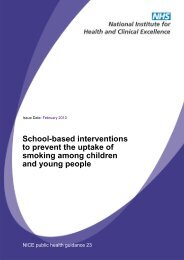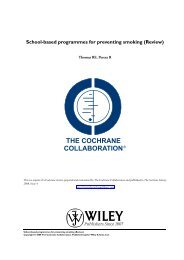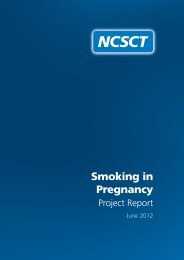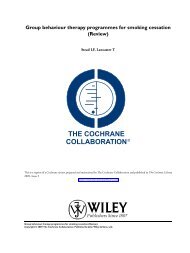Smoking and mental health - NCSCT
Smoking and mental health - NCSCT
Smoking and mental health - NCSCT
Create successful ePaper yourself
Turn your PDF publications into a flip-book with our unique Google optimized e-Paper software.
Population strategies to prevent smoking in <strong>mental</strong> disorders 6<br />
SSS. 55 Given that SSS are extremely cost-effective it is therefore important to<br />
improve the availability, awareness, access <strong>and</strong> uptake of SSS among smokers<br />
making a quit attempt, to maximise the chances of success.<br />
6.2.9 Preventing smoking uptake through school-based interventions<br />
Cigarette smoking is a behaviour that generally begins in adolescence, <strong>and</strong><br />
particularly during the years spent in secondary education. In Engl<strong>and</strong>, only 9%<br />
of 11 year olds have ever tried a cigarette, whereas, by age 15, 55% have done so<br />
<strong>and</strong> 15% are regular smokers. 56 Schools have therefore been a focus of efforts to<br />
influence smoking behaviour <strong>and</strong> prevent smoking uptake. However, most of the<br />
published evidence evaluating the effectiveness of such school-based<br />
interventions is from the USA, <strong>and</strong> it is not clear whether these findings are<br />
applicable to the UK, where the context of the <strong>health</strong> <strong>and</strong> education systems, <strong>and</strong><br />
extent of tobacco control policy implementation, is different. 57,58<br />
The available evidence suggests, however, that school-based <strong>health</strong> promotion<br />
programmes to inform adolescents about the prevalence <strong>and</strong> <strong>health</strong> risks of<br />
smoking, <strong>and</strong> programmes to teach young people social <strong>and</strong> personal skills such<br />
as decision-making, stress that management <strong>and</strong> assertiveness have limited<br />
impact on smoking uptake. 57,58 Interventions to make adolescents aware of peer,<br />
family <strong>and</strong> media influences on their behaviour, correct their overestimates of<br />
smoking prevalence in their peers <strong>and</strong> society as a whole, <strong>and</strong> encourage them to<br />
make public commitments not to smoke, have been reported to have positive<br />
short-term <strong>and</strong> longer-term effects on youth smoking prevalence, but these<br />
findings have not been confirmed in higher-quality studies. 58 The UK ASSIST<br />
study has demonstrated that a peer-led education programme reduces uptake of<br />
smoking in young people in the short term, 59 although it is not clear whether<br />
this effect is sustained. It has been suggested that more comprehensive<br />
approaches, which tackle wider societal issues <strong>and</strong> involve intervention with<br />
students’ families <strong>and</strong> the communities in which they live, may also be<br />
effective. 57,60,61<br />
6.2.10 Harm reduction<br />
The potential importance of promoting nicotine substitution for people who<br />
smoke <strong>and</strong> otherwise cannot or do not want to quit smoking has been<br />
highlighted by the RCP as a potential means to decrease some of the harmful<br />
effects of smoking, 62 <strong>and</strong> to increase the likelihood of future quit attempts (see<br />
section 5.3). Harm reduction, ideally comprising complete substitution of<br />
smoked tobacco with an alternative source of nicotine, offers substantial<br />
potential to prevent smoking-related disease <strong>and</strong> provides an alternative for<br />
smokers obliged to comply with smoke-free regulation. Section 5.3 summarises<br />
© Royal College of Physicians 2013 115














